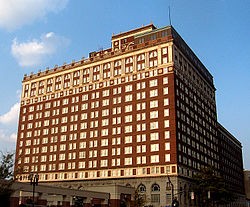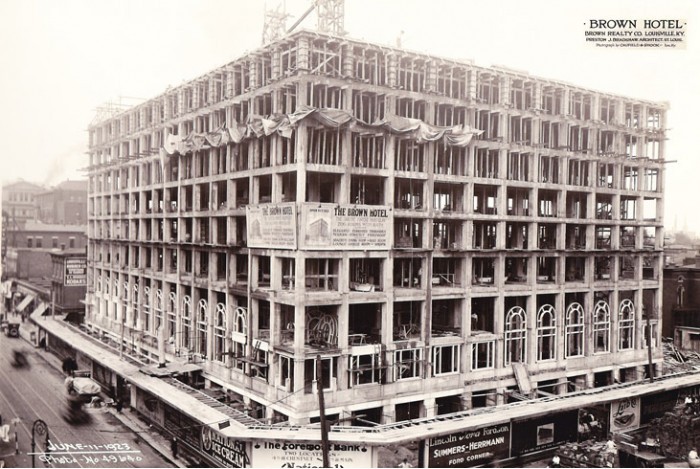Brown Hotel
Introduction
Text-to-speech Audio
In 1923, Louisville was the 34th largest city in America with a population of 235,000. That was the same year that J. Graham Brown opened the Georgian Revival-style hotel, in great anticipation of the local population and newspapers. The Brown Hotel would soon inspire an entire downtown rejuvenation effort that would come to include businesses, movie theaters, a residential community, and a parking garage. An ordinary hotel might not inspire so much rejuvenation, but this was the Brown Hotel, and it was not ordinary in any way, with its very first visitor in the guest register being David Lloyd George, former prime minister of Britain.
Images
The Brown Hotel

The Brown Hotel, 1923, Construction

Backstory and Context
Text-to-speech Audio
The opening of the J. Grahm Brown's "Brown Hotel" was one of the most anticipated events of 1923 in Louisville. On October 25, 1923, 1,923 people attended the hotel's first opening dinner and dance party. The next night another 1,200 guests attended the second opening dinner. The following Saturday, it is said that a further 10,000 people flooded the hotel as it opened its doors to the general public for the first time.
In retrospect, it appears that all the anticipation for the hotel was absolutely deserved, as the Brown Hotel transformed the city. The hotel was in no time at all the social center of Louisville. As the glory days of the 1920s continued, theaters, churches, and professional offices sprouted up around the hotel. J. Graham Brown even built his own theater near the hotel, which still today is in operation. People began referring to the neighborhood surrounding the hotel as the "magic corner," with so much of the life of Louisville converging in this special place at 4th and Broadway.
During the Prohibition (which was in effect from the opening of the hotel until 1933), the hotel suffered for its effect on business. However, it survived, and names like Lily Pons, Al Jolson, and Queen Marie of Rumania are all a part of those early years.
A very notable piece of its history was during the Flood of '37. The Ohio River, by which Louisville sits, crested 34.2 feet above flood level on January 27. However, the river did not return to normal levels until around mid-February. Nearly 1,000 residents of Louisville found refuge in the 15-story hotel during this time.
The Brown finally found itself no longer struggling to survive during World War II, when soldiers from nearby Ft. Knox would seek a chance to put their struggles away for an evening at the Brown Hotel. The hotel hit its stride during this era and enjoyed a boom in business.
During the spring of 1961 The Brown Hotel became one of the targets of the "Nothing New for Easter" boycotts. The boycott served as economic activism against local businesses which discriminated against African Americans and led to the accomplishment of Louisville's Public Accommodations Act. The protests resulted in the arrests of seven hundred, primarily Black, citizens who participated in the strike.
Today any visitor can ask the older staff for stories, and each will be able to recount the legends and tales of these different eras. It is a hotel absolutely packed with its unique history and beginnings.
In retrospect, it appears that all the anticipation for the hotel was absolutely deserved, as the Brown Hotel transformed the city. The hotel was in no time at all the social center of Louisville. As the glory days of the 1920s continued, theaters, churches, and professional offices sprouted up around the hotel. J. Graham Brown even built his own theater near the hotel, which still today is in operation. People began referring to the neighborhood surrounding the hotel as the "magic corner," with so much of the life of Louisville converging in this special place at 4th and Broadway.
During the Prohibition (which was in effect from the opening of the hotel until 1933), the hotel suffered for its effect on business. However, it survived, and names like Lily Pons, Al Jolson, and Queen Marie of Rumania are all a part of those early years.
A very notable piece of its history was during the Flood of '37. The Ohio River, by which Louisville sits, crested 34.2 feet above flood level on January 27. However, the river did not return to normal levels until around mid-February. Nearly 1,000 residents of Louisville found refuge in the 15-story hotel during this time.
The Brown finally found itself no longer struggling to survive during World War II, when soldiers from nearby Ft. Knox would seek a chance to put their struggles away for an evening at the Brown Hotel. The hotel hit its stride during this era and enjoyed a boom in business.
During the spring of 1961 The Brown Hotel became one of the targets of the "Nothing New for Easter" boycotts. The boycott served as economic activism against local businesses which discriminated against African Americans and led to the accomplishment of Louisville's Public Accommodations Act. The protests resulted in the arrests of seven hundred, primarily Black, citizens who participated in the strike.
A magnificent representation of the 1930s, The Brown Hotel displayed characteristics of early twentieth century architecture and reflectedthe context of the downtown Louisville's culture. The architectural achievements of The Brown Hotel earned positive impressions among the community for their hospitable accommodations to all attending patrons. The Brown hotel inspired a centralized hub of activity located in the Louisville Downtown area that aided the integration of social connectivity.
Today any visitor can ask the older staff for stories, and each will be able to recount the legends and tales of these different eras. It is a hotel absolutely packed with its unique history and beginnings.
Cite This Entry
Leadingham, Christopher et. al. "Brown Hotel ." Clio: Your Guide to History. May 15, 2017. Accessed April 17, 2025. https://theclio.com/entry/12558
Sources
http://be478d95e8aa404656c1-d983ce57e4c84901daded0f67d5a004f.r11.cf1.rackcdn.com/brownhotel/media/Hi...

